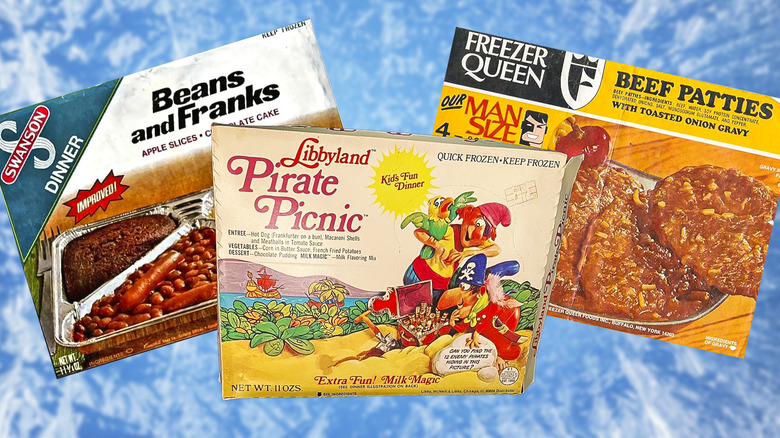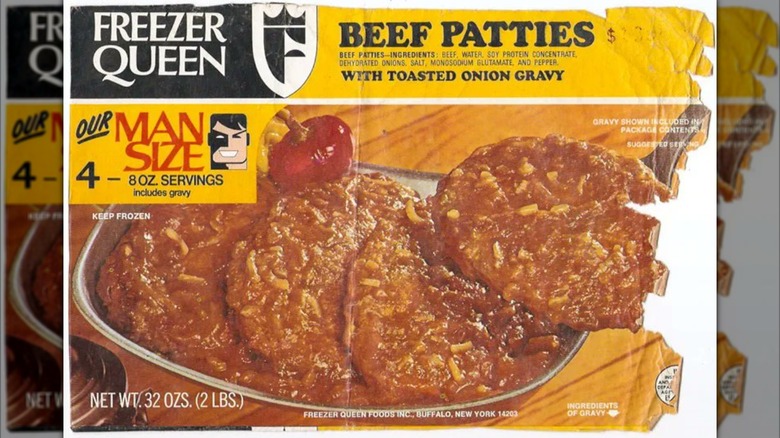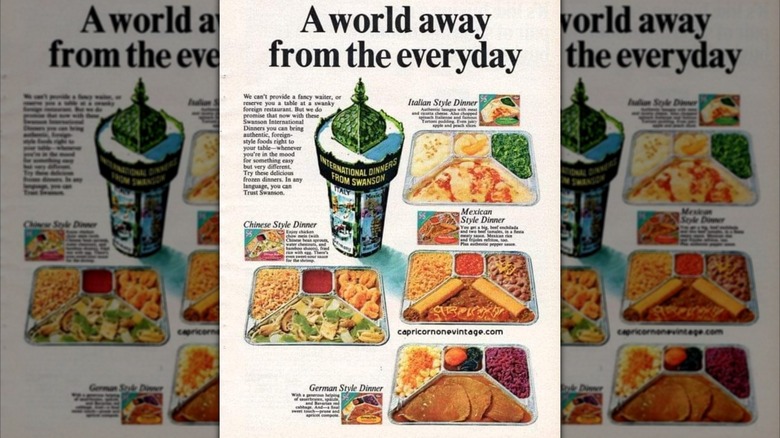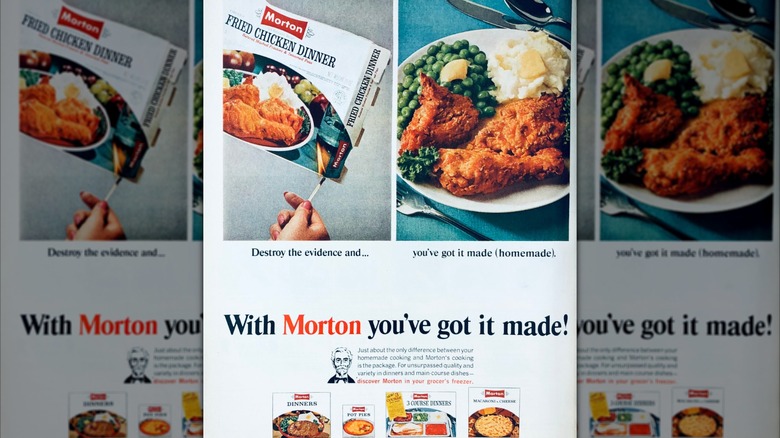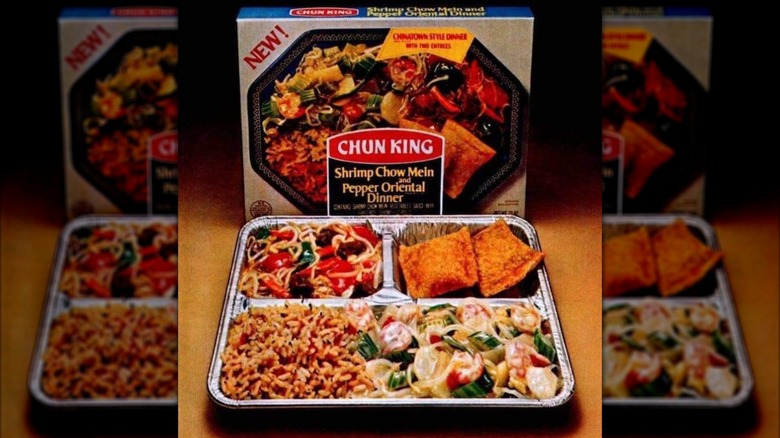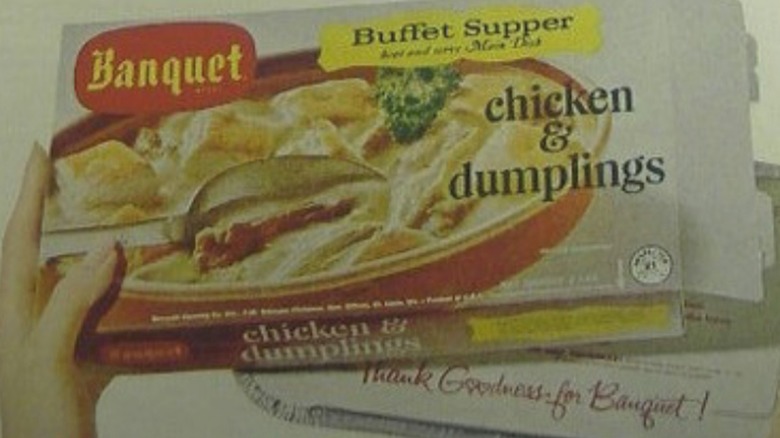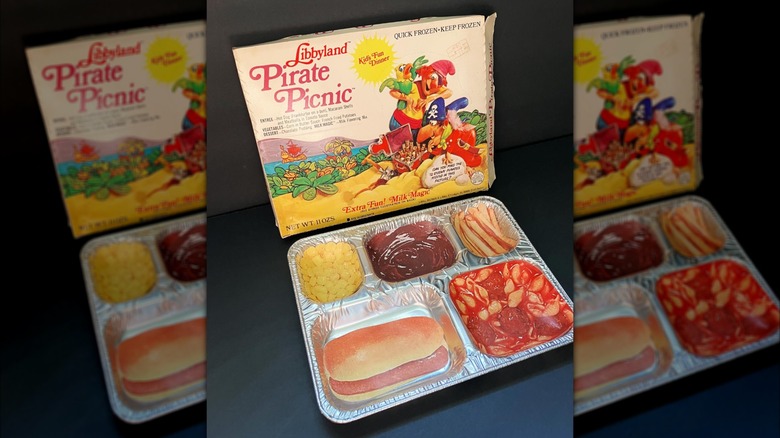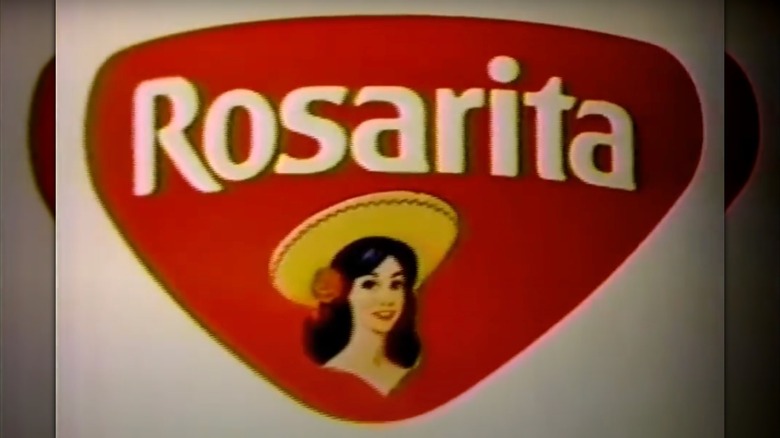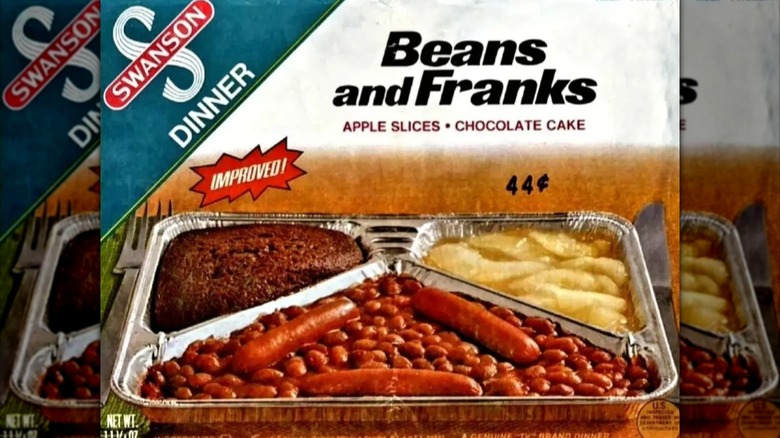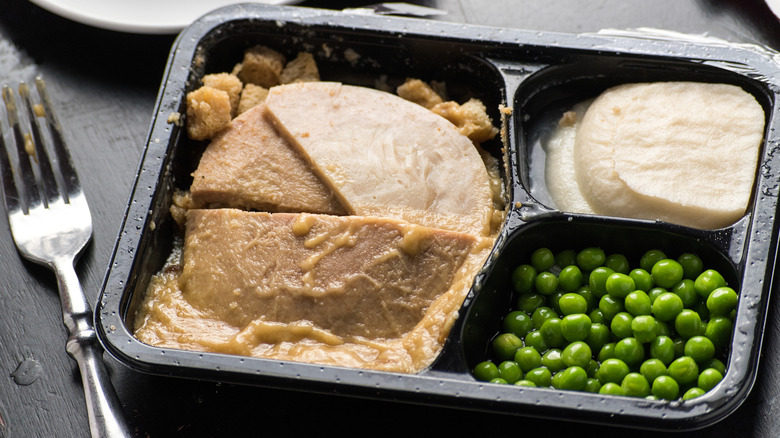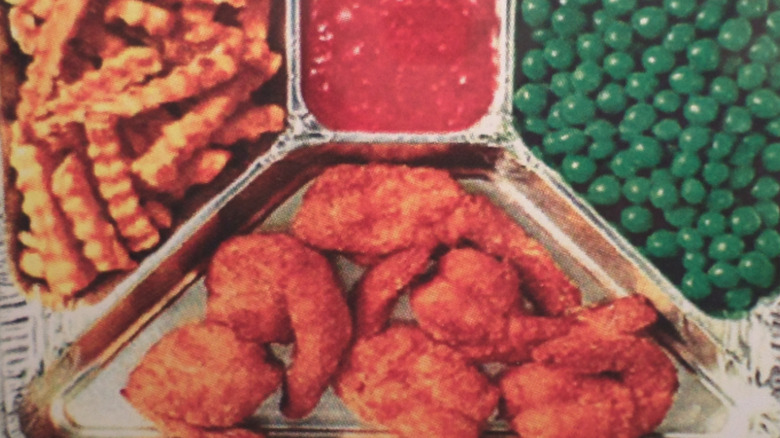Old School Frozen TV Dinners That Everyone Forgot About
Although they may still be around today, the heyday of frozen TV dinners is long gone. Back in the 1950s they were all the rage: Invented in a post-war environment that valued convenience and comfort, they soon became people's go-to option for an alternative to a home-cooked meal. Millions of frozen dinners were sold across the country, and a range of companies began to compete for people's pocketbook. Heavy hitters like Swanson, Morton, and Freezer Queen all tried to outdo each other on the selection of meals they could offer. It was common to see frozen TV dinners come with an appetizer, entrée, and dessert, a selection that would make some modern customers jealous.
However, it appeared that the market just couldn't sustain itself — and as people began to look elsewhere for their dinners and turn back to home cooking, a lot of these frozen options died out. Products that were once the talk of the town were removed from shelves — and people pretty much forgot all about them. Well, we didn't. We've been keeping tabs on old school frozen dinners for quite a while, and we decided that it's time to take a deep-dive into our favorite brands and flavors.
Freezer Queen dinners
Freezer Queen was one of the most prominent businesses selling frozen dinners back in the day (which wasn't especially hard — there weren't a lot of them around, to be honest). The company was founded in 1958, and soon became a major player, employing a massive amount of people in the Buffalo area and making a giant amount of frozen dinners for folks nationwide. Freezer Queen didn't try to reinvent the wheel with its meals, instead focusing on homely offerings like salisbury steak, meatloaf, and beef patties – which are all kinda the same thing, we'll admit, but they were probably pretty tasty.
Well, that's until people found out what was actually going on in Freezer Queen's plant. In 2004, its Buffalo facility was shut down after USDA inspectors found a host of issues with its operations and health and safety violations. This event marked the end of a long and rocky journey for the company, which had been acquired by various businesses in the preceding decades, in pretty quick succession. When it was shut down for good, its frozen dinners disappeared.
Swanson Mexican Style dinner
Swanson frozen TV dinners are possibly the king of them all. While it didn't invent the concept, it pioneered the development and sale of the frozen turkey dinner, with Swanson salesman Gerry Thomas stumbling across the concept that would eventually make the company's name. Swanson went on to become the most prominent frozen TV dinner business around, and was especially well-known for its homely holiday classics, which typically came with a side and some veggies.
However, what a lot of people don't know is that Swanson didn't just focus on American food. Back in the late '60s it released its International Dinners range, which promised folks meals from all around the world in the comfort of their homes. People could pick from an Italian style dinner, which had a meat and ricotta lasagna and sautéed spinach; a Chinese style dinner, with chicken chow mein, fried rice, and battered shrimp; or a Mexican style dinner.
This last one was a lot of people's favorites, and we get why. Every tray came complete with a beef enchilada, two beef tamales, Mexican rice, frijoles refritos, and a pepper sauce to give everything a hint of spice. Talk about range, huh?
Morton Old Kentucky Recipes
Morton is a familiar name in the frozen TV dinner world, and was for a long time considered the main competitor to Swanson. Maybe that's because, like Swanson, it offered customers an impressive array of food in each tray. Every TV dinner came with an entrée, side, and vegetable, and although you got slightly less selection than a Swanson TV dinner, you gained more in portion size for every item. We're not sure about the quality of these TV dinners' ingredients, but they were still popular.
Our favorite Morton meals came from its Old Kentucky Recipes range. These dinners focused on good old-fashioned dishes that people knew and loved, and Morton didn't pull any punches with its offerings. Most famous was a Fried Chicken Dinner, which was equipped with three pieces of chicken, mashed potatoes, and peas. Morton advertised it with an image of someone setting fire to the box after they'd cooked the meal, to fool their guests that they had made it from scratch.
Perhaps most curious is the mascot it picked to market its Old Kentucky Recipes: A white-haired, moustached man who had more than a passing resemblance to Colonel Sanders.
Chun King dinners
As soon as there were frozen dinners, there were Chinese-American frozen dinners. Okay, maybe that's not quite true — it took more than a decade from the development of frozen TV dinners for dishes like chow mein and fried rice to be sold widely. Once it started, however, there was no stopping it. Frozen TV dinners featuring Chinese-American cuisine were largely pioneered by Chun King, a company founded by the child of Italian immigrants, Jeno F. Paulucci. In 1947, Paulucci spotted the gap in the market for mass-produced Chinese-American food, and began selling various forms of canned and frozen dishes nationwide.
With all this in mind, it's hard to call Chun King foods authentic (and some might have dubbed them some of the worst frozen meals out there), but for a while they were big business. Its frozen dinners used the format of other companies, offering a main, side, and dessert in one tray. As time went on, Chun King's dinners became more elaborate: One frozen meal from 1974 had shrimp chow mein, fried rice, pepper beef and egg rolls. You could also find chicken chow mein and sweet and sour pork further down the aisle. Chun King was eventually acquired by ConAgra, which saw the decline and death of the brand — but some food historians remember it well.
Banquet Chicken and Dumplings
Is there anything more comforting than chicken and dumplings? Not according to Banquet. The frozen food company first started selling its wares in 1953, beginning with frozen meat pies. Pretty soon it expanded into frozen dinners, focusing on homestyle classics that it knew people would love. One of these, its chicken and dumplings, was a flagship product for the company. Banquet marketed it heavily in print advertising, focusing on its ability to provide what felt like a home-cooked meal without having to lift a finger. It also promised that the dish would taste expensive without costing the world. Brave words, Banquet!
This hefty frozen dinner, which weighed in at 2 pounds per package, was clearly meant to feed a crowd. It also came with a side of mashed potatoes, carrots, and peas. Banquet's chicken and dumplings frozen TV dinner was clearly popular enough to stick around for a while, and the company continued to make modernized versions of it. Nowadays, though, it's gone from its product line. The closest you'll find in stores today is its Creamy Chicken and Biscuits Bake.
Libbyland Pirate Picnic
If you had kids in the 1970s, you'll remember Libbyland. If you didn't, you'll likely have no idea what it is. Well, we'll explain: Libbyland was a range of products released by Libby's, the stalwart canned foods company, which has been around since 1869. Libbyland was its way to try and corner the kid's market, and to make a range of frozen dinners that little ones would enjoy, both for their flavor and for the sense of fun they evoked.
As such, executives at Libby's duly went to work on creating a range of scenarios and worlds that they would theme their meals around. One of these, Libbyland Pirate Picnic, featured a pair of pirates on the box encountering a chest full of gold, complete with a parrot on one of their shoulders.
Inside the frozen dinner was an impressive range of food. You got a hot dog, a portion of beefaroni (or a sloppy Joe, depending on when you bought it, some French fries, a side of corn, and a few scoops of chocolate pudding. Finishing the meal would reveal the Libbyland characters engraved into the bottom of each metal tray. There's no denying how fun these would have been if you were a kid.
Rosarita frozen dinners
Frozen TV dinners throughout history have often felt incredibly similar, especially through the 1950s and '60s. It felt like every meal was some variation on a turkey dinner, with a sauce-covered meat, a side of some kind of potatoes, and a few veggies. Luckily, if you didn't want that, you could pick up a Rosarita meal. Rosarita (which was first known as Rosita) was a company started decades before it began making frozen meals. It all began when Pedro Guerrero opened a tamale booth in 1929 with a partner. And 16 years went by before he was able to acquire funding for his company Rosita, and another 14 went by before the renamed Rosarita went public.
At that point, Rosarita was making frozen foods and selling them to a market desperate for a little variety. Items like its beef enchilada dinner came with two enchiladas, three beef tacos, and a portion of refried beans, for the price of just $0.59. Its Mexican style dinner, meanwhile, came with tamales and Mexican rice. Although Guerrero passed away in 1990, the Rosarita brand is still going today, now controlled by ConAgra brands.
Swanson Beans and Franks
Beans and franks is a dish that hits the spot every time, and that combined with its simple nature has meant that it's been a favorite of prepared food companies. In the 1960s Swanson leapt on its evergreen appeal by releasing its Beans and Franks TV dinner. Every box promised three large franks swimming in beans in the main compartment, and it came with not one but two desserts: A hunk of chocolate cake and a portion of apple slices. A complete meal in one freezer-safe box? Consider us sold.
Unsurprisingly, this frozen dinner evokes a lot of nostalgia among those that have tried it, and while most people have long forgotten Swanson's Beans and Franks, there are still some folks out there with fond memories. "I can taste that cake like it was yesterday. The apples, too," said one person on Reddit in a thread about the meal. Others pointed out the hilarity of how long these meals would actually take, even though they promised you an easier dinner experience. "And it took just 45 minutes to preheat the oven, cook the dinner, let it cool down, and serve."
Morton Turkey dinner
Swanson wasn't the only company that could make a turkey dinner. Back in the day, its main competitor Morton was also rustling up a turkey dinner of its own. This frozen TV dinner promised — as so many did — a full meal in one box. In your main compartment you had your turkey meat, sliced and ready to go in a pool of gravy and dressing. A portion of buttery mashed potatoes sat over its right shoulder, while a mass of seasoned carrots sat to the left.
Morton's upgraded turkey dinner seemed to be a successor to its Old Kentucky turkey option, which came with peas instead of carrots. This new version, though, fell into the same trap of overpromising and underdelivering. A glance at the marketing data on the back of the box promises "full portions" (in block capital letters, no less), but this meal weighed in at less than 1 pound. Not exactly generous.
Swanson Fried Shrimp dinner
Frozen TV dinners often get a bad rap for their texture. We get that: So many of them are soupy, syrupy, and bland. Ever since the first days of frozen dinners, companies have been trying to introduce crunch into their meals, and Swanson's Fried Shrimp Dinner was an early example of this. This meal took the joys of battered shrimp, fries, and peas, and put them all into one handy tray. It also came complete with a portion of cocktail sauce embedded right into the middle of the metal dish, which introduced some much-needed moisture to the meal.
Although we're not sure how all of these different foods would fare together in one tray, it seems like they were a hit at the time. What's especially touching is how much they evoke treasured memories of childhood in the folks who do remember them. "These were a big treat to us kids during this era, since our large family rarely purchased them," said one nostalgic person over on Reddit. "We looked forward to those special occasions when we could have one." Okay, so why are we crying about a frozen TV dinner?
